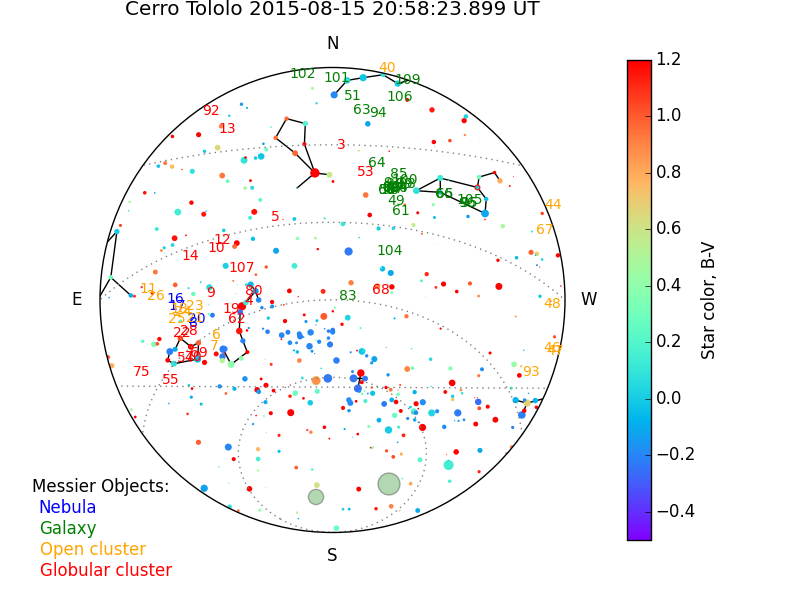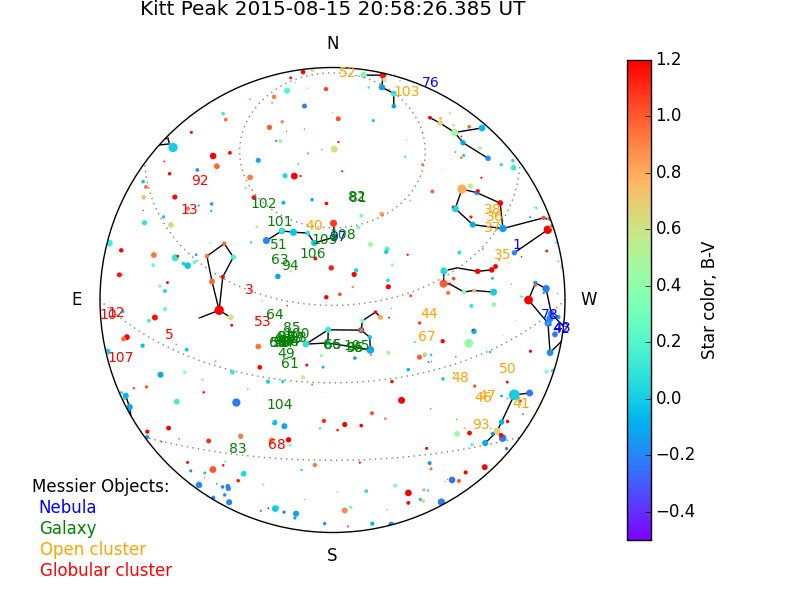 |
 |
I occasionally do presentations for classes, school visits, or other kinds of meetings that generate (possibly) interesting visuals. Here are a few that may be useful to other people:
For Live Astronomy at DragonCon 2015, I have a Python routine that will show what is overhead from each SARA telescope site at the moment (assuming the system time call returns time zone). Messier objects are shown by number color-coded as to whether nebula, galaxy, star cluster. I got carried away and coded stars by color, and added outlines of about 20 of the most familiar constellations for orientation. Here a sample set of plots:
 |
 |
There are certainly much better Pythonisti out there; be gentle! I will probably add features soon anyway. For anyone who wants to look under the hood, the code and auxiliary files are:
(In detail - ybs.degbv has star from the Yale Bright-Star Catalog sorted by brightness, along with ID and color information,notably the B-V color index. For convenience, the coordinates have been converted to decimal degrees at equinox 2000.0. Messier.txt has the list of Messier objects in similar form, with a code for the broad category (galaxy, nebula, open/globular star cluster. Constellations.txt defined lines to draw selected constellation patterns, by giving pairs of stars (via their YBS numbers) to connect. The code uses the standard Python packages sys, os, matplotlib, numpy, and scipy, as well as the more specialized astropy. There is a command to append astropy to the internal path so I could make it work for development with Spyder on my laptop.
Astronomical Tourism from DragonCon 2012 (27 Mbyte PDF with lnks).
A talk on "Hanny's Voorwerp and the Rise of the Digital Amateur Astronomer", given as part of the 2010: A Space Oddity sessions on March 4, 2010. Audio is available as an 8.8-Mbyte MP3. You can see a much-compressed PDF of the screen visuals. Finally, you can replay the audio with synchronized display-screen capture here (this may need to download a browser plugin from our Tegrity system).
A talk on "Galaxy Zoo and Hanny's Voorwerp" given to the Birmingham Astronomical Society in October 2008. See the visuals in PDF format (compressed for space) and listen to the audio ((33 Mb MP3). Truth in advertising compels me to point out that we ended up not being able to record the talk live, so I redid the narration later. As best I can tell, this version was less entertaining than the one for a live audience (as well as being a good bit shorter). You also have to figure out when to page forward...
Presentations at Dragon*Con 2008. There are PDF files on dark matter, the Great Observatories, and Galaxy Zoo. (I also posted the Galaxy Zoo memory game).
Some of my musings on faith and reason (13 Mbyte PowerPoint from a series of talks given to the UA Christian Faculty/Staff Fellowship).
PowerPoint file for presentation on "The History of Galaxies" for College Leadership Board, 8 September 2006.
PowerPoint files for talks at DragonCon 2006: "Astrophysics from your Backyard - and your Laptop", showing opportunities for involvement in research with amateur equipment or on-line; and my 2006 status report on NASA's Great Observatories, with a wider look forward on multiwavelength astronomy.
PowerPoint slides for Living in Einstein's Universe, an Einstein centennial presentation tracing the myriad impacts of relativity in contemporary astronomy. This version was given to the Barnard-Seyfert Astronomical Society, and is somewhat revised from what I did at DragonCon 2005. For the Web, I have deleted a couple of archival pictures for which I have purchased rights for print but not the Web.
PowerPoint material from talks at DragonCon 2005, on NASA's Great Observatories, the search for extrasolar planets, and a curmudgeonly view of the search for extraterrestrial intelligence.
A status report on the new UA 16-inch telescope (11 Mbyte PowerPoint). This includes the equipment and sample images from digital and 35mm cameras, webcam, and CCD imager.
From DragonCon 2004 - two items presented in the Science and Space Track. First is the material for a talk on the first stars and the first black holes. Then you can find the visuals I used in a panel discussion on NASA's Great Observatories, with a focus on the status and fate of Hubble. The recorded talks themselves will shortly be available on streaming audio from madscientist.org.uk. Please ignore the cell phone when my son the gamer called to ask about ordering pizza. Twice.
Formation and Evolution of Galaxies, put together for Rainwater Observatory's star party in spring 2004.
A couple of items from elementary- and high-school talks: a presentation on the Solar System at the high-school level, and one on careers in science for the younger set.
Mars in myth, literature, and history. This has grown through public programs at the oppositions of 2001 and 2003.
The cosmic background for life on Earth. This was prepared as an introductory lecture for a course on evolutionary biology, and covers the formation of structure and the synthesis of the chemical elements.
Did the Apollo landings really happen?. This is a discussion of the evidence that I use in classes. On the same topic, I also have a page on telescopic tracking of the Apollo lunar missions.
Last changes: August 2015